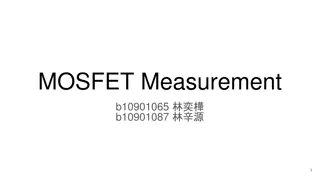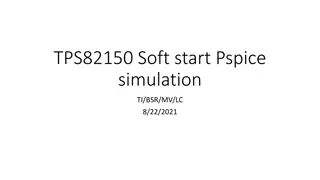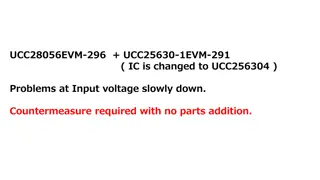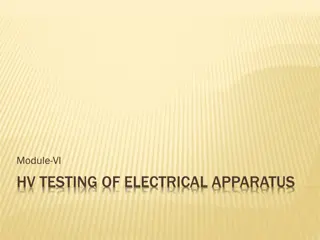Understanding Voltage and Electrical Potential in Physics
Explore the concepts of voltage, electrical potential, work, and charge through practical examples involving moving charges against electric and gravitational fields. Learn how to calculate voltage, work done, and gravitational potential changes in various scenarios. Dive into the world of electrica
3 views • 23 slides
Understanding Power System Analysis: Voltage Drop Equations and Phasor Diagrams
Explore the derivation and application of voltage drop equations over transmission lines in power systems, considering inductive and capacitive loads. Learn how to draw phasor diagrams for different scenarios and understand the approximations used to analyze voltage losses.
6 views • 22 slides
Understanding Voltage Drop in Electrical Systems
Electrical calculations often focus on current or voltage drop to determine proper conductor sizes. Excessive voltage drop can lead to issues like flickering lights, poor heating, and overheating of motors, requiring attention to wire sizes and the National Electrical Code recommendations. Explore t
0 views • 20 slides
Understanding Voltage in Circuits: Effects and Applications
Explore the concept of voltage in circuits, its significance in electricity, and the effects of varying voltages on components like bulbs, motors, and buzzers. Discover how different voltage levels impact the brightness of a bulb, the loudness of a buzzer, and the overall performance of electrical d
0 views • 11 slides
Understanding Performance of Transmission Lines in Electrical Engineering
The performance of a transmission line in power systems is critical for efficient operation. Factors such as voltage drop, line losses, and transmission efficiency are key considerations in design and operation. The line parameters of resistance, inductance, capacitance, and shunt conductance play c
2 views • 26 slides
Understanding Voltage Divider Biasing in Transistors
Study how to bias a transistor for linear operation using a resistive voltage divider connected to a single source. Learn the design principles, loading effects, stability considerations, and how to calculate key parameters for a successful voltage divider bias circuit.
0 views • 9 slides
DC Machine Armature Windings Overview
Learn about the construction and types of armature windings in DC machines, including lap wound and wave wound armatures. Discover how lap wound armatures are suitable for low voltage, high current applications, while wave wound armatures are used in high voltage, low current scenarios. Understand t
0 views • 18 slides
Understanding Series Circuit Calculations for Voltage, Current, and Power
Exploring the calculations in a series circuit to determine voltage, current, power, and total resistance. Learn the formulas and steps to find these values, emphasizing the relationship between resistance, current, and voltage drops in the circuit.
0 views • 12 slides
Understanding Waveform Generators in Electronic Circuits
Waveform generators, such as square wave oscillators and triangular wave generators, play crucial roles in electronic circuits. Square wave oscillators use capacitors and op-amps to create square wave outputs through charging and discharging processes. On the other hand, triangular wave generators u
1 views • 11 slides
Understanding Feedback Amplifiers in Electronic Circuits
Feedback amplifiers play a crucial role in electronic circuits by providing mechanisms for controlling gain, stability, and overall performance. There are two basic types of feedback - positive and negative, each offering distinct advantages. The four ways of connecting feedback signals involve volt
0 views • 18 slides
Understanding Power Quality and Its Impact on Electrical Systems
Power quality refers to the characteristics of electrical power that drives sensitive equipment. It involves voltage and current deviations from ideal waveforms, impacting the efficiency and reliability of electrical systems. Various types of power quality phenomena exist, such as voltage variations
1 views • 16 slides
Overview of High Voltage Pulsed Stimulation (HVPS) in Medical Applications
High Voltage Pulsed Stimulation (HVPS) is a versatile form of electrical stimulation used in various medical applications such as wound healing, muscle reduction, nerve stimulation, and pain control. Originally developed in 1945, HVPS delivers monophasic current with unique features like fixed durat
0 views • 34 slides
Understanding Superposition Theorem in Electrical Circuits
Superposition theorem in electrical circuits states that the effects of multiple voltage and current sources in a network can be analyzed independently and then combined algebraically. This allows for calculating the voltage and current distribution in a network more efficiently. The theorem involve
0 views • 9 slides
MC-OOK Symbol Design for IEEE 802.11 - March 2018
Introducing MC-OOK waveforms with low peak-to-average power ratio for IEEE 802.11, utilizing 256-QAM modulation and 4 MHz bandwidth. The design methodology involves generating time-domain waveforms, transforming to frequency domain, and proposing symbols with and without DC subcarriers. Detailed sym
0 views • 20 slides
Understanding Band-Gap Voltage References in Microelectronic Systems
Voltage references provide stable output voltages unaffected by variations in supply voltage, temperature, and process errors. This summary delves into the principles of band-gap voltage references and their crucial role in creating precise control voltages for ADCs, DACs, and various other applicat
1 views • 14 slides
Morphologic and Physiologic Connections in Blood Pressure Waveforms for Cardiovascular Event Prediction
This report discusses the morphologic and physiologic connections in continuous blood pressure waveforms and their association with incident cardiovascular events. The study aims to assess if changes in arterial elasticity contribute to predicting CVD events and explores additional measures derived
0 views • 30 slides
Understanding Dynamic Voltage and Frequency Scaling in Advanced VLSI
Explore the concepts of Dynamic Voltage and Frequency Scaling (DVFS) in Advanced VLSI design. Learn about the impact on clocking, STA, and testing, as well as considerations for selecting the right voltage and frequency settings. Discover how controlling voltage affects power consumption and computa
0 views • 51 slides
Understanding Phase Difference and Phase Shift in Sinusoidal Waveforms
Phase difference and phase shift describe the angular displacement of sinusoidal waveforms in degrees or radians. These concepts are crucial in analyzing the relationship between alternating quantities such as voltage and current. The phase angle determines the shift of a waveform along the horizont
1 views • 26 slides
Understanding Alternating Current and Voltage Waveforms
Alternating current and voltage exhibit specific waveform patterns such as sinusoidal waves. The sinusoidal waveform, including sine waves and harmonics, is fundamental in AC circuits. Sources like alternators produce sinusoidal voltages, while electronic signal generators create various waveforms f
0 views • 70 slides
Understanding Zener Diodes and Breakdown Characteristics
Zener diodes play a crucial role in electronic circuits by allowing current flow in both forward and reverse biased conditions. When reverse biased voltage is applied, zener diodes exhibit a unique behavior called breakdown, where a sudden rise in current occurs leading to zener voltage and zener cu
0 views • 21 slides
Understanding Zener Diodes in Analog Electronics
Zener diodes are heavily doped semiconductor devices designed to operate in reverse bias conditions. They exhibit the Zener effect where breakdown occurs, allowing current flow in the reverse direction. These diodes maintain a constant voltage (Zener voltage) across them, making them useful as volta
3 views • 12 slides
Understanding Zener Diodes for Voltage Regulation
Zener diodes are special diodes designed to have a low reverse breakdown voltage, making them ideal for voltage regulation purposes. When biased in the reverse direction, they provide a stable voltage output regardless of changes in current. This property can be effectively utilized to stabilize vol
0 views • 18 slides
Understanding Diode Circuits and Rectifiers for Power Supplies
Exploring the functionality of diode circuits in series and parallel configurations, along with clippers, clampers, and voltage multipliers. Gain insights into power supplies such as half-wave and full-wave rectifiers, Vrms derivation, Ripple Factor, and more. Learn about diode behavior in rectifica
4 views • 58 slides
Understanding Oscilloscopes: Functions, Working, and Usage
Oscilloscopes, commonly known as O-Scopes, are essential tools for measuring AC signals with varying frequencies. They help in interpreting waveforms, correcting waveforms in real-time, and working alongside Function Generators. There are analog and digital oscilloscopes, each with specific working
1 views • 14 slides
MOSFET Measurement Experiment Overview
This experiment involves measuring pFET and nFET devices by applying voltage on drain and gate to measure drain-source current. Geometric parameters of the devices are analyzed, including width, length, and aspect ratios. Detailed measurements and comparisons are made for different types of FETs, sh
0 views • 24 slides
Understanding Electric Circuits: Current, Voltage, and Resistance
Electric circuits involve the flow of electric current through conductors with varying levels of resistance. Current (I) is the amount of charge passing through a point in a wire per unit of time, measured in amperes. Voltage (V) is the potential difference required to make electrons flow in a condu
0 views • 25 slides
Soft Start Simulation Results for TPS82150 Power Module
Results of soft start simulations for TPS82150 power module show that the rise time for output voltage slightly exceeds the expected soft start time due to voltage ramping up to 0.8V only. Different scenarios for input voltage and output current levels are explored, highlighting the impact on rise t
0 views • 4 slides
Understanding Input and Output Limitations in Op Amps
Explore the various input and output limitations in TI Precision Labs Op Amps as presented by Ian Williams and prepared by Art Kay and Ian Williams. Delve into common mode voltage, voltage swing, data sheet parameters translation, input and output stages, examples of common mode voltage, and potenti
0 views • 15 slides
Voltage Readings and Rules for Troubleshooting Wiring and System Issues
Data on voltage readings derived from bench testing in a controlled environment are provided as a reference for troubleshooting wiring and unit issues. General rules and guidelines for voltage measurements at various locations within the system are outlined, along with specific instructions for cont
0 views • 23 slides
Understanding AC, Diodes, and Power Supplies in Analog Electronics
This chapter delves into the intricacies of AC and DC waveforms, exploring RMS voltage, diodes, power supplies, and semiconductor devices like voltage regulators. Through graphical analysis and Ohm's Law, the relationship between AC and DC voltages is clarified, enabling the conversion of RMS to pea
0 views • 25 slides
Troubleshooting AC Input Voltage Variations in UCC28056EVM-296 and UCC25630-1EVM-291
Addressing issues with input voltage fluctuations in UCC28056EVM-296 and UCC25630-1EVM-291, where the voltage slowly decreases under different load conditions. Problems include output stopping at varying AC voltages based on load and hunching behavior at different load levels. Countermeasures are ne
0 views • 7 slides
Enhancing Secure Channel Estimation with Zero-Padded Waveforms in IEEE 802.11-17
Secure channel estimation is crucial for protecting against attackers in wireless networks. This document discusses the use of zero-padded waveforms to safeguard ranging waveforms and mitigate CP-replay threats in IEEE 802.11-17 standard, enhancing security and performance in channel estimation.
0 views • 12 slides
Feedback Loop Compensation Design Using UCC28740 for Voltage Regulation
Explore the detailed design and control laws for a feedback loop compensation system using UCC28740 in a flyback regulator schematic diagram. The control law profile in CV mode, multiple control regions, and gain blocks are discussed for achieving high efficiency in voltage regulation. Gain blocks d
0 views • 16 slides
Understanding Harmonics in Electromagnetic Environments
In the realm of electromagnetic environments, the generation of electromagnetic interference (EMI) through harmonics plays a crucial role. This article delves into the concept of harmonics, their generation in simple DC power supplies, and the impact they have on electronic devices. From the basics
0 views • 31 slides
Understanding Voltage, Current, Resistance, and Ohm's Law
Learn the fundamentals of voltage, current, resistance, and power, along with insights into Ohm’s Law. Discover how these concepts are interconnected and essential for understanding electrical circuits. Explore the unit of voltage, the movement of electrical current, the concept of resistance, and
0 views • 5 slides
Comprehensive Review of BJT CE Voltage Amplifier in Electronics Lab
This lecture provides a comprehensive review of the BJT CE voltage amplifier circuit, starting with theoretical concepts and moving towards practical implementations. It covers the operation of the BJT as a switch, the addition of resistors for current control, DC design considerations, AC voltage g
0 views • 19 slides
Understanding High Voltage Testing of Transformers
This detailed presentation covers the importance and procedures of high voltage testing for transformers. It highlights the purpose, objectives, tests involved, equipment used, and safety measures to ensure the reliability and longevity of transformers. Various tests like AC Withstand Voltage Test,
0 views • 7 slides
High Voltage Testing of Electrical Apparatus: Terminology, Test Facilities, and Procedures
Understanding general terminology in high voltage testing such as disruptive discharge, withstand voltage, flashover, and creepage distance. Explore the test facilities provided in high voltage laboratories and the different tests conducted on equipment like transformers, lightning arresters, and ca
0 views • 22 slides
Survey of High-Level Open-Source Tool-Flows for Rapid Prototyping of SDR Waveforms
This research project explores the use of high-level open-source tool-flows for rapidly prototyping software-defined radio (SDR) waveforms. It delves into the motivation, design productivity gap, basics of SDR, ideal requirements for high-level SDR tool-flows, and a survey of potential tools. The st
0 views • 17 slides
Zero-Padded Waveform for Secure Channel Estimation in IEEE 802.11-17
Security is a vital aspect in IEEE 802.11az, particularly in secure ranging applications. This document introduces zero-padded waveforms to protect channel estimation against attackers aiming to manipulate the range of STAs. The proposal outlines requirements, including the need to eliminate predict
0 views • 12 slides







































